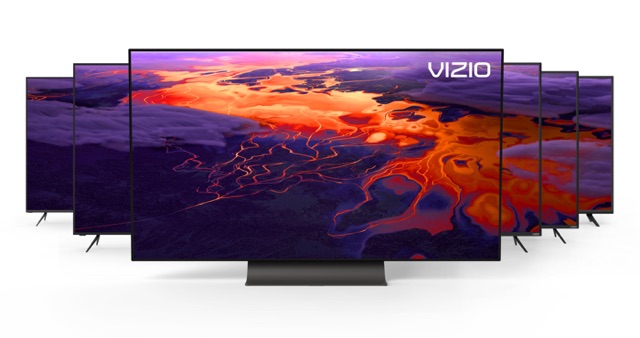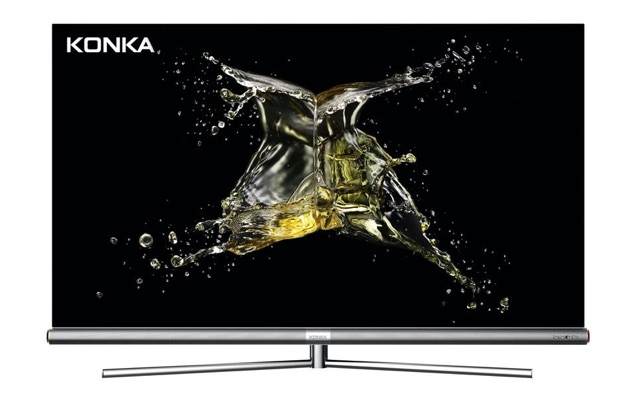For eagle-eyed videophiles, nothing serves their “20-20” vision better than OLED panel-based TVs, which build beautiful pictures from millions of self-emissive organic light emitting diodes. And at CES 2020, that picture’s growing brighter with improved OLED tech.
OLED TVs with unmatched true black levels, infinite contrast, razor-edge imaging and superior off-angle viewing are being introduced, endorsed and demonstrated by a broad and competitive group of companies. Until now, OLED’s principal big screen panel-maker was LG Electronics, and it demanded a premium price for that tech. We’re hoping that the competition means the high cost of OLED screens will be dropping — but only time will tell how much prices may drop.
Budget brand Vizio now offers OLED sets

Vizio is earning attention in Vegas this week with two 2020-release OLED models – in 55- and 65-inch sizes – enhanced with the brand’s IQ Ultra processor “for unparalleled color, contrast and clarity.” Virtually borderless and just 4 mm thin, these OLED displays are designed to pair with the new Vizio Elevate Sound Bar, an interesting 5.1.4 channel Dolby Atmos and DTS:X audio presenter with rotating front-height speakers that can be twisted for different applications. Like all other sets in Vizio’s 2020 line, these OLEDs will also feature a new Filmmaker Mode (backed by the UHD Alliance) which will automatically set screen parameters for optimum performance with specially coded Ultra High Definition content.
New Chinese manufacturers enter the OLED market

Also plunging into OLED waters at CES are the Chinese brands Hisense, Konka and Skyworth – which is no surprise given a newly opened LG- and Chinese-partnered OLED plant in the Guangzhou Development District of China. Though it has experienced some startup kinks, which have limited the plant’s output, it’s soon expected to produce 60,000 big screen panels a month in 55-, 65- and 77-inch sizes.
Hisense, already selling its first OLED TV in the UK, is at CES 2020 touting new technologies in its OLEDs. The company claims its support engine eliminates any chances of screen after-image and the latest screens have cranked up maximum brightness to 900 nits.
Skyworth — a company that's huge in China but new to the States — is touting a “wallpaper thin” (4.6 mm at its slimmest point) OLED with a curious design twist for multi-tasking screen devotees. The W81 comes with a secondary, detachable 21-inch screen for monitoring time and weather and IOT devices like security cameras. And if you go hog wild for the W81 Pro edition, the package also comes with the “Swaiot Panel,” a 4-inch or 10.1-inch detachable display that offers “more control over your content and smart home ecosystem.”
Coming in spring 2020, Konka North America will deliver two X11 series OLED sets as part of a series line that also includes LED and QLED-based models. The company’s OLED sets will be available in 55- and 65-inch Ultra High Definition sizes, with “HiBright” panels, a “ColorWave” Ultra Wide Color gamut and a “Zero Bezel” cabinet with built-in sound bar and dbx TV sound.
Sony announced its first 48 inch OLED, the A9S. It uses an LG sourced panel but is customized with Sony touches like Acoustic Surface which turns the screen itself into a speaker.
Funai Corporation is at CES previewing Philips-branded 4K OLED TVs with Ambilight, available in Europe and “coming soon” to the U.S. Lending extra pop to the pictures, Ambilight washes the back wall around the TV with colored light complimenting the dominant tones playing on the screen. And, if you wish, will also trigger nearby Philips Hue lightbulbs (installed in fixtures) to do likewise.
LG remains the premium OLED manufacturer
LG, for its part, will stay at the front of the pack with premium-quality screens. LG Signature OLED 8K TVs will be available in 88- and 77-inch sizes, and thy exceed the Consumer Technology Association’s minimum specs to offer what LG is calling “Real 8K” performance. Big spenders will also want LG’s a9 Gen processor, which includes AI Picture Pro circuitry to automatically find and enhance facial features and text; Auto Genre selection to apply best image quality settings for movie, sports, standard and animation; and AI Sound Pro to selectively tweak the audio for music, movies, sports, drama and news.
At the other end of the size spectrum, LG will also offer its first under-55-inch OLED this year – a 48-inch 4K UHD display being pitched equally for gamers and video viewers.
With more OLED TV manufacturers than ever entering the market, we're hopeful that this high-end TV tech will become more affordable as these new models hit store shelves.
[Updated on 1/7/2020 with information on Sony and Philips]
[Image credit: Vizio, Konka, Techlicious]
















